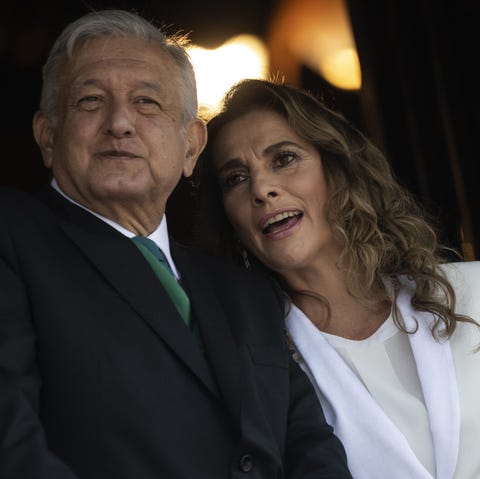In February 9, 25-year-old former beauty queen Ingrid Escamilla was allegedly stabbed to death and dismembered by her boyfriend in Mexico City’s Vallejo neighborhood.
One week later, a 7-year-old girl named Fátima disappeared in nearby Xochimilco, where she was waiting to be picked up from school. Her body was found wrapped in a plastic bag.
These cases—just two of almost 1,000 Mexican women killed in 2020—led to mass protests outside Palacio Nacional in Mexico City, where demonstrators called for action against the femicide crisis that’s terrified women for years.
Femicide, or “feminicido” in Spanish, is the murder of a woman because of her gender. Cases in Mexico have increased by 137 percent in the last five years, the country’s Attorney General Alejandro Gertz Manero said in February.
That stunning number has provoked outrage and led to a nationwide women’s strike in March, promoted on social media using the hashtag #UnDíaSinMujeres or #OneDayWithoutWomen. Here’s everything you need to know about the attacks on women just because they’re women—and how the issue is being addressed by the Mexican government.

What is femicide?
Femicide is the “intentional murder of women because they are women,” according to the World Health Organization, but can more broadly include “any killings of women or girls.”
Most femicide crimes are committed by “partners or ex-partners, and involve ongoing abuse in the home, threats or intimidation, sexual violence or situations where women have less power or fewer resources than their partner,” according to WHO. It has been a federal crime in Mexico since 2012.

What’s happening in Mexico now?
Among the countries with the highest rates of femicide in the world, 14 are in Latin America and the Caribbean region, according to the UN. In 2019, there were 1,006 reported incidents of femicide in Mexico, which is a 10 percent increase from 2018, according to The New York Times. In the first four months of 2020, nearly 1,000 women and girls have been killed, according to CNN. In April alone, 267 women were murdered, which CNN calls the “deadliest month in the last five years.”
According to Reuters, violence against women has soared since the COVID-19 pandemic hit Latin America, “confirming fears that lockdowns would put many women in danger.”
Like many nations, Mexico has a long, sad history of violence against women. In the 1990s and early 2000s, the murder of around 400 girls and women in Ciudad Juarez, a border town across the Rio Grande river, shed light on the crisis. This 2003 article from Texas Monthly has more information on the brutality that took place in the city writer Cecilia Ballí describes as “Ciudad de la Muerte.”

A performance artist demands justice for activist Isabel Cabanillas de la Torre, who was found dead in Ciudad Juarez after disappearing.
How is Mexico responding?
A top official in Mexico vowed last year to make the issue of violence against women “a priority for the government.” But many women feel Mexico’s President Andrés Manuel López Obrador has brushed off the crisis. In reference to the 26,171 people who called the country’s emergency call center in March about violent incidences against women, López Obrador said: “Ninety percent of those calls that you’re referring to are fake.”
When asked directly about the high number of killings of women in Mexico, he said it had “been manipulated a lot in the media.” He then blamed femicide on “the neoliberal model,” according to The New York Times.
López Obrador’s wife, First Lady Beatriz Gutierrez, reportedly condemned a planned strike by women against femicide, according to Al Jazeera, calling instead for a “rally” in support of her husband.

There have been calls to action, like the push for Ley Ingrid (Ingrid’s Law) to stop the spread of leaked images from open police investigations. According to The Washington Post, some members of Mexico’s National Congress proposed the creation of a special committee for femicide, citing a “state of national emergency.”
Several activists and journalists are also working to bring awareness to the crisis. Maria Salguero is documenting and investigating femicide cases in Mexico with a map tracking victims. This profile of Salguero in Vice describes her mapping process. This content is imported from Twitter. You may be able to find the same content in another format, or you may be able to find more information, at their web site.
Women in Mexico are protesting, demanding action.
Women are banding together, calling for accountability and change. On International Women’s Day in March, thousands of protestors flooded the streets for a national strike against gender-based violence, posted to social media using the hashtags #NiUnaMenos. Related Story How the World’s Loudest Feminist Anthem Came to Be
The strike was the latest step in the country’s fight against the abuse of women. In 2019, a young activist’s tweet jumpstarted the #MeToo movement in Mexico. And the Chilean protest song “A Rapist in Your Way” has made its way to Mexico, too. The chant has been performed in 52 countries and is a stirring resistance act in the global movement to address transnational violations of women’s rights.
by Rose Minutaglio for ELLE
Source: ELLE
The Mazatlan Post



